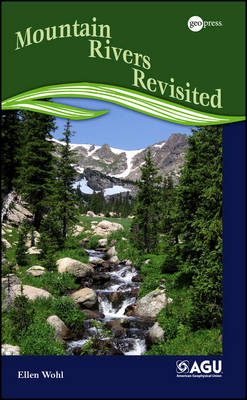
Mountain Rivers Revisited
American Geophysical Union
978-0-87590-323-1 (ISBN)
- Titel z.Zt. nicht lieferbar
- Versandkostenfrei innerhalb Deutschlands
- Auch auf Rechnung
- Verfügbarkeit in der Filiale vor Ort prüfen
- Artikel merken
Published by the American Geophysical Union as part of the Water Resources Monograph Series, Volume 19.
What are the forms and processes characteristic of mountain rivers and how do we know them? Mountain Rivers Revisited, an expanded and updated version of the earlier volume Mountain Rivers, answers these questions and more. Here is the only comprehensive synthesis of current knowledge about mountain rivers available. While continuing to focus on physical process and form in mountain rivers, the text also addresses the influences of tectonics, climate, and land use on rivers, as well as water chemistry, hyporheic exchange, and riparian and aquatic ecology. With its numerous illustrations and references, hydrologists, geomorphologists, civil and environmental engineers, ecologists, resource planners, and their students will find this book an essential resource.
Ellen Wohl received her Ph.D. in geology in 1988 from the University of Arizona. Since then, she has worked primarily on mountain and bedrock rivers in diverse environments.
Ellen Wohl received her Ph.D. in geology in 1988 from the University of Arizona. Since then, she has worked primarily on mountain and bedrock rivers in diverse environments.
Preface vii
1. Introduction 1
1.1. Characteristics of Mountain Rivers 2
1.2. Advances Since the First Edition 3
1.3. Purpose and Organization of This Volume 4
1.4. A Mountain River Described and Enumerated 5
1.4.1. North St. Vrain Creek, Colorado, USA 8
2. Mountain Drainage Basins 13
2.1. Mountain Rivers and Tectonics 14
2.2. Hillslopes 20
2.2.1. Controls on Slope Morphology 21
2.2.2. Steady-State Hillslopes 23
2.2.3. Bedrock Weathering and Soils 24
2.2.4. Mass Movements 25
2.2.4.1. Landslides 26
2.2.4.2. Debris flows 28
2.2.5. Diffusive Sediment Transport on Hillslopes 35
2.2.5.1. Creep 35
2.2.5.2. Rainsplash and overland flow 36
2.2.5.3. Modeling diffusive transport 38
2.2.6. Modeling Slope Morphology and Sediment Movement 39
2.3. Climate and Hydrology 40
2.3.1. Generation of Precipitation 41
2.3.2. Glacier and Snow Melt 45
2.3.3. Down Slope Pathways of Water 46
2.3.4. Modeling Hillslope Hydrology 55
2.3.5. Pressing Hydrologic Needs for Mountain Regions 57
2.4. Channel Initiation and Development 58
2.4.1. Channel Initiation 58
2.4.2. Channel Network Development 64
2.5. Basin Morphometry and Basin-Scale Patterns 65
2.5.1. Basin Morphometry and Hydrology 67
2.5.2. Hydraulic Geometry 70
2.5.3. Downstream Fining 73
2.6. Valley Morphology 75
2.7. Longitudinal Profiles and Bedrock Channel Incision 78
2.7.1. Processes of Bedrock Channel Erosion 81
2.7.2. Models of Bedrock Channel Incision 84
2.8. Knickpoints and Gorges 87
2.9. Terraces 92
2.10. Alluvial Fans 96
2.11. Summary 102
3. Channel Processes 103
3.1. Hydrology 103
3.1.2. Paleoflood Indicators 107
3.1.3. Modeling Stream Discharge 111
3.1.4. Bankfull Discharge 112
3.1.5. Floods 114
3.1.5.1. Outburst floods 116
3.1.5.2. Geomorphic effects of floods 119
3.2. The Hyporheic Zone 123
3.3. River Chemistry 128
3.3.1. Dissolved Nutrients 133
3.3.2. Organic Matter and Gases 136
3.3.3. Trace Metals and Pollutants 138
3.4. Hydraulics 141
3.4.1. Resistance Coefficient 141
3.4.2. Resistance Partitioning 149
3.4.3. Velocity and Turbulence 154
3.4.4. Bed Shear Stress 163
3.4.5. Stream Power 165
3.5. Sediment Processes 166
3.5.1. Bed Sediment Characterization 166
3.5.1.1. Sampling and measurement 166
3.5.1.2. Coarse surface layers 169
3.5.2. Particle Clusters 171
3.5.3. Sediment Entrainment 172
3.5.4. Measurement of Bedload Transport 179
3.5.5. Mechanics of Bedload Transport 182
3.5.6. Downstream Bedload Transport Patterns, Rates, and Frequency 185
3.5.7. Bedload Transport Equations 191
3.5.8. Bedload Yield and Sediment Budgets 197
3.5.9. Processes of Deposition 205
3.5.10. Suspended Sediment 207
3.6. Bank Stability 213
3.7. Instream Wood 215
3.8. Channel Stability and Downstream Trends 223
3.9. Summary 226
4. Channel Morphology 229
4.1. Spatial and Temporal Variability in Channel Morphology 229
4.2. Channel Classification Systems 234
4.3. Channel Morphologic Types 236
4.3.1. Step-Pool Channels 236
4.3.2. Plane-Bed Channels 242
4.3.3. Pool-Riffle Channels 243
4.4. Incised Alluvial Channels 249
4.5. Braided Channels 250
4.6. Anabranching Channels 255
4.7. Spatial Distribution of Morphologic Types and Network Heterogeneity 256
4.8. Summary 257
5. Mountain River Biota 259
5.1. River Ecology 259
5.1.1. Only Connect 259
5.1.2. The Physical and Chemical Environment of a River Ecosystem 262
5.2. Aquatic Communities 264
5.3. Riparian Communities 269
5.3.1. Basic Characteristics 269
5.3.2. Interactions Between Riparian Vegetation and Channel Processes 272
5.4. Conceptual Models 277
5.5. Biological Stream Classifications 283
5.6. Mountain River Ecosystems 284
5.7. Case Studies of Human Impacts to Mountain River Ecosystems 286
5.7.1. The Columbia River Basin 286
5.7.2. The Danube River Basin 288
5.8. Summary 292
6. Mountain Rivers and Humans 295
6.1. Types of Impact 296
6.1.1. Indirect Impacts 297
6.1.2. Direct Impacts 313
6.2. Contemporary Status of Mountain Rivers 327
6.3. Hazards 328
6.3.1. Debris Flows 329
6.3.2. Landslides 334
6.3.3. Floods 336
6.4. River Management 339
6.4.1. Restoration and Rehabilitation 339
6.4.2. Instream and Channel Maintenance Flows and the Natural Flow Regime 345
6.5. Summary 346
7. Field Data, Experiments, Computers, Brains 349
Glossary 353
References 357
Index 565
| Reihe/Serie | Water Resources Monograph |
|---|---|
| Sprache | englisch |
| Maße | 150 x 226 mm |
| Gewicht | 953 g |
| Themenwelt | Sachbuch/Ratgeber ► Natur / Technik ► Naturführer |
| Naturwissenschaften ► Geowissenschaften ► Geophysik | |
| Naturwissenschaften ► Geowissenschaften ► Hydrologie / Ozeanografie | |
| ISBN-10 | 0-87590-323-1 / 0875903231 |
| ISBN-13 | 978-0-87590-323-1 / 9780875903231 |
| Zustand | Neuware |
| Haben Sie eine Frage zum Produkt? |
aus dem Bereich
